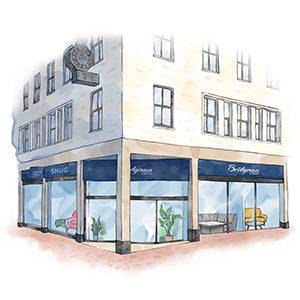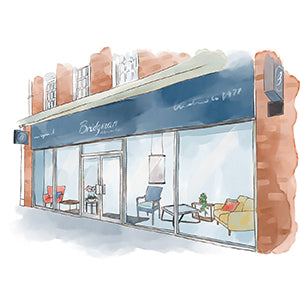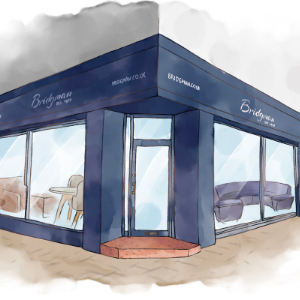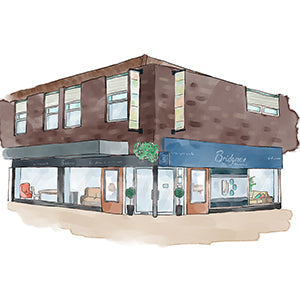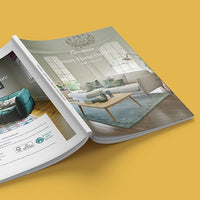Bridgman’s exclusive outdoor weather-resistant cushions are made from a durable material well suited to surviving the elements. However, even stain-resistant fabrics can get dirty. From mild to severe stains, follow the instructions below to clean each one and keep your furniture looking brand new.
Waterproof Cushion Care Guide
-
Absorb any spills quickly using a paper towel. Follow by cleaning with a soft brush and mild soapy water.
-
In the unlikely event that a stain remains, we recommend applying a 30% bleach solution to the fabric.
-
Wash all cleaning products away with clean water before allowing to dry.
-
In order to allow the cushions to breathe, the cushions are vented. This allows a small amount of moisture to be absorbed inside the covers. However, under normal conditions, this will not be noticed and will dry out quickly.
-
As long as care is taken not to get water inside the venting panels, the cushions can be hosed clean or jet washed on a low-power setting.
-
Never dry-clean or machine-wash your cushions. This will damage the membrane and compromise the waterproof capabilities.
-
During long periods of wet weather, all base cushions should be pulled forward to allow the back cushion to drop down to rest on the seat frame so that minimal moisture is able to enter through the air vent panels. Lift and turn cushions to allow circulation of air to damp areas.
-
If the insides of the cushions do get wet, simply open the zips and face the inner cushion toward the sunshine to allow them to dry naturally. In the unlikely event that the fillings become saturated, the covers must be removed to allow the inner cushion to dry fully.
-
If you use your cushions in a pool area, we strongly recommend periodically rinsing the cushions with water to avoid unsightly, difficult-to-remove white marks caused by chlorine build-up on the fabric.
-
To prolong their life we recommend storing all cushions in a dry place when not in use, particularly during autumn and winter. Our selection of cushion bags and storage boxes are available to shop online or in-store.
-
Ensure your cushions are completely dry before they are stored away. Check them regularly to ensure mould, mildew and rodents do not pose a problem.
FOOD STAINS
Simply scrub with a washing up brush and warm soapy water. For oily foods, refer to our guide to grease and oil-based stains further down this page.
WINE SPILLS
Our fully stain-resistant cushions mean that red wine spills can be wiped straight off to leave a clean cushion. If the stain dries on the cushion fabric, it can be cleaned off with warm water and a sponge.
COFFEE SPILLS
Coffee stains can be removed in exactly the same way as wine spills. Our stain-resistant cushions allow coffee to be wiped straight off with a paper towel to leave a clean cushion. Use warm water and a sponge to clean the stain off if it has dried down.
PEN MARKS
To remove pen marks, first try cleaning the stain with warm soapy water. If this does not remove the mark, apply a 30% bleach solution to the area and wipe away.
SEVERE STAINS - MILDEW & MOULD
Before detailing how to remove mould from cushions, it’s important to note that it is easily prevented. Acrylic fabric is man-made, so nothing can grow on this material. Therefore, if mould forms on your cushions, this is because it is growing on something else on your cushion e.g. damp. Simply ensure that cushions are dry and clean when storing to prevent mould from forming in the first place.
The key to treating mould stains is to clean the cushion as soon as you see the mould forming. Dilute 1 cup of bleach and ¼ cup of mild soap per 5 litres of water. Use a spray bottle to apply the solution to the affected area and allow to soak for 15 minutes. Then, clean the mould off of the cushion with a washing up brush or nail brush. If there is still some mould remaining, spray the cushion with a jet washer. If jet washing causes water to get inside of the cushion, open the zip to let air in.
GREASE & OIL BASED STAINS
Grease and oil-based stains are the most difficult to remove. Some of the most common oil stains include greasy foods and suncream.
First, either scrape off any dried grease using a plastic utensil or, if the stain is wet, blot any excess using a damp paper towel. Sprinkle baking soda on the stain, making sure it is completely covered. Let the baking soda absorb for 15 to 20 minutes. Vacuum the baking soda off of the stained area. Dampen a cloth with liquid detergent and press into the affected area. Finish by using a jet washer to get off any oil or grease that you may have missed. If jet washing causes water to get inside of the cushion, open the zip to let air in.
PRESERVING YOUR CUSHIONS
To prevent damage to the seams of your cushions, do not lift them by holding onto the back seam's zipper or the side vents - these are not intended as handles and this can cause premature failing of the thread. Instead, hold the cushions firmly in both hands on either side whenever you need to move or place them.

